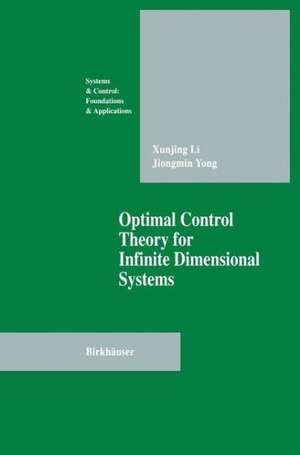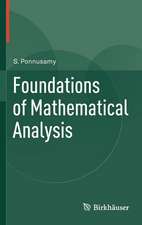Optimal Control Theory for Infinite Dimensional Systems: Systems & Control: Foundations & Applications
Autor Xungjing Li, Jiongmin Yongen Limba Engleză Hardback – 22 dec 1994
| Toate formatele și edițiile | Preț | Express |
|---|---|---|
| Paperback (1) | 1388.22 lei 6-8 săpt. | |
| Birkhäuser Boston – 30 sep 2011 | 1388.22 lei 6-8 săpt. | |
| Hardback (1) | 1395.94 lei 6-8 săpt. | |
| Birkhäuser Boston – 22 dec 1994 | 1395.94 lei 6-8 săpt. |
Din seria Systems & Control: Foundations & Applications
- 18%
 Preț: 1050.34 lei
Preț: 1050.34 lei - 17%
 Preț: 490.56 lei
Preț: 490.56 lei - 15%
 Preț: 654.95 lei
Preț: 654.95 lei - 15%
 Preț: 654.43 lei
Preț: 654.43 lei - 15%
 Preț: 641.85 lei
Preț: 641.85 lei -
 Preț: 404.51 lei
Preț: 404.51 lei -
 Preț: 400.10 lei
Preț: 400.10 lei -
 Preț: 394.51 lei
Preț: 394.51 lei - 15%
 Preț: 640.37 lei
Preț: 640.37 lei - 15%
 Preț: 635.80 lei
Preț: 635.80 lei - 15%
 Preț: 646.11 lei
Preț: 646.11 lei - 18%
 Preț: 790.28 lei
Preț: 790.28 lei -
 Preț: 382.36 lei
Preț: 382.36 lei -
 Preț: 386.39 lei
Preț: 386.39 lei - 18%
 Preț: 946.24 lei
Preț: 946.24 lei - 18%
 Preț: 961.10 lei
Preț: 961.10 lei - 18%
 Preț: 968.19 lei
Preț: 968.19 lei -
 Preț: 388.34 lei
Preț: 388.34 lei - 15%
 Preț: 645.47 lei
Preț: 645.47 lei -
 Preț: 404.13 lei
Preț: 404.13 lei - 18%
 Preț: 965.02 lei
Preț: 965.02 lei - 15%
 Preț: 649.87 lei
Preț: 649.87 lei - 18%
 Preț: 974.98 lei
Preț: 974.98 lei -
 Preț: 386.00 lei
Preț: 386.00 lei -
 Preț: 393.52 lei
Preț: 393.52 lei - 15%
 Preț: 642.68 lei
Preț: 642.68 lei -
 Preț: 390.84 lei
Preț: 390.84 lei -
 Preț: 388.72 lei
Preț: 388.72 lei - 15%
 Preț: 655.45 lei
Preț: 655.45 lei - 20%
 Preț: 1003.63 lei
Preț: 1003.63 lei - 15%
 Preț: 648.89 lei
Preț: 648.89 lei - 15%
 Preț: 645.47 lei
Preț: 645.47 lei -
 Preț: 386.00 lei
Preț: 386.00 lei - 18%
 Preț: 952.89 lei
Preț: 952.89 lei -
 Preț: 396.40 lei
Preț: 396.40 lei - 15%
 Preț: 642.68 lei
Preț: 642.68 lei - 15%
 Preț: 650.19 lei
Preț: 650.19 lei
Preț: 1395.94 lei
Preț vechi: 1702.38 lei
-18% Nou
Puncte Express: 2094
Preț estimativ în valută:
267.11€ • 278.34$ • 221.17£
267.11€ • 278.34$ • 221.17£
Carte tipărită la comandă
Livrare economică 03-17 aprilie
Preluare comenzi: 021 569.72.76
Specificații
ISBN-13: 9780817637224
ISBN-10: 0817637222
Pagini: 450
Ilustrații: XII, 450 p.
Dimensiuni: 155 x 235 x 27 mm
Greutate: 0.87 kg
Ediția:1995
Editura: Birkhäuser Boston
Colecția Birkhäuser
Seria Systems & Control: Foundations & Applications
Locul publicării:Boston, MA, United States
ISBN-10: 0817637222
Pagini: 450
Ilustrații: XII, 450 p.
Dimensiuni: 155 x 235 x 27 mm
Greutate: 0.87 kg
Ediția:1995
Editura: Birkhäuser Boston
Colecția Birkhäuser
Seria Systems & Control: Foundations & Applications
Locul publicării:Boston, MA, United States
Public țintă
ResearchCuprins
1. Control Problems in Infinite Dimensions.- §1. Diffusion Problems.- §2. Vibration Problems.- §3. Population Dynamics.- §4. Fluid Dynamics.- §5. Free Boundary Problems.- Remarks.- 2. Mathematical Preliminaries.- §1. Elements in Functional Analysis.- §1.1. Spaces.- §1.2. Linear operators.- §1.3. Linear functional and dual spaces.- §1.4. Adjoint operators.- §1.5. Spectral theory.- §1.6. Compact operators.- §2. Some Geometric Aspects of Banach Spaces.- §2.1. Convex sets.- §2.2. Convexity of Banach spaces.- §3. Banach Space Valued Functions.- §3.1. Measurability and integrability.- §3.2. Continuity and differentiability.- §4. Theory of Co Semigroups.- §4.1. Unbounded operators.- §4.2. Co semigroups.- §4.3. Special types of Co semigroups.- §4.4. Examples.- §5. Evolution Equations.- §5.1. Solutions.- §5.2. Semilinear equations.- §5.3. Variation of constants formula.- §6. Elliptic Partial Differential Equations.- §6.1. Sobolev spaces.- §6.2. Linear elliptic equations.- §6.3. Semilinear elliptic equations.- Remarks.- 3. Existence Theory of Optimal Controls.- §1. Souslin Space.- §1.1. Polish space.- §1.2. Souslin space.- §1.3. Capacity and capacitability.- §2. Multifunctions and Selection Theorems.- §2.1. Continuity.- §2.2. Measurability.- §2.3. Measurable selection theorems.- §3. Evolution Systems with Compact Semigroups.- §4. Existence of Feasible Pairs and Optimal Pairs.- §4.1. Cesari property.- §4.2. Existence theorems.- §5. Second Order Evolution Systems.- §5.1. Formulation of the problem.- §5.2. Existence of optimal controls.- §6. Elliptic Partial Differential Equations and Variational Inequalities.- Remarks.- 4. Necessary Conditions for Optimal Controls — Abstract Evolution Equations.- §1. Formulation of the Problem.-§2. Ekeland Variational Principle.- §3. Other Preliminary Results.- §3.1. Finite codimensionality.- §3.2. Preliminaries for spike perturbation.- §3.3. The distance function.- §4. Proof of the Maximum Principle.- §5. Applications.- Remarks.- 5. Necessary Conditions for Optimal Controls — Elliptic Partial Differential Equations.- §1. Semilinear Elliptic Equations.- §1.1. Optimal control problem and the maximum principle.- §1.2. The state coastraints.- §2. Variation along Feasible Pairs.- §3. Proof of the Maximum Principle.- §4. Variational Inequalities.- §4.1. Stability of the optimal cost.- §4.2. Approximate control problems.- §4.3. Maximum principle and its proof.- §5. Quasilinear Equations.- §5.1. The state equation and the optimal control problem.- §5.2. The maximum principle.- §6. Minimax Control Problem.- §6.1. Statement of the problem.- §6.2. Regularization of the cost functional.- §6.3. Necessary conditions for optimal controls.- §7. Bounary Control Problems.- §7.1. Formulation of the problem.- §7.2. Strong stability and the qualified maximum principle.- §7.3. Neumann problem with measure data.- §7.4. Exact penalization and a proof of the maximum principle.- Remarks.- 6. Dynamic Programming Method for Evolution Systems.- §1. Optimality Principle and Hamilton-Jacobi-Bellman Equations.- §2. Properties of the Value Functions.- §2.1. Continuity.- §2.2. B-continuity.- §2.3. Semi-concavity.- §3. Viscosity Solutions.- §4. Uniqueness of Viscosity Solutions.- §4.1. A perturbed optimization lemma.- §4.2. The Hilbert space X?.- §4.3. A uniqueness theorem.- §5. Relation to Maximum Principle and Optimal Synthesis.- §6. Infinite Horizon Problems.- Remarks.- 7. Controllability and Time Optimal Control.- §1. Definitions ofControllability.- §2. Controllability for linear systems.- §2.1. Approximate controllability.- §2.2. Exact controllability.- §3. Approximate controllability for semilinear systems.- §4. Time Optimal Control — Semilinear Systems.- §4.1. Necessary conditions for time optimal pairs.- §4.2. The minimum time function.- §5. Time Optimal Control — Linear Systems.- §5.1. Convexity of the reachable set.- §5.2. Encounter of moving sets.- §5.3. Time optimal control.- Remarks.- 8. Optimal Switching and Impulse Controls.- §1. Switching and Impulse Controls.- §2. Preliminary Results.- §3. Properties of the Value Function.- §4. Optimality Principle and the HJB Equation.- §5. Construction of an Optimal Control.- §6. Approximation of the Control Problem.- §7. Viscosity Solutions.- §8. Problem in Finite Horizon.- Remarks.- 9. Linear Quadratic Optimal Control Problems.- §1. Formulation of the Problem.- §1.1. Examples of unbounded control problems.- §1.2. The LQ problem.- §2. Well-posedness and Solvability.- §3. State Feedback Control.- §3.1. Two-point boundary value problem.- §3.2. The Problem (LQ)t.- §3.3. A Fredholm integral equation.- §3.4. State feedback representation of optimal controls.- §4. Riccati Integral Equation.- §5. Problem in Infinite Horizon.- §5.1. Reduction of the problem.- §5.2. Well-posedness and solvability.- §5.3. Algebraic Riccati equation.- §5.4. The positive real lemma.- §5.5. Feedback stabilization.- §5.6. Fredholm integral equation and Riccati integral equation.- Remarks.- References.
Recenzii
"This book goes plenty of new ways, which should be interesting also for the expert on this topic...this book is an excellent matured presentation of the modern subject 'Optimal processes' being also very clearly arranged in its typography."
--ZAA
--ZAA












